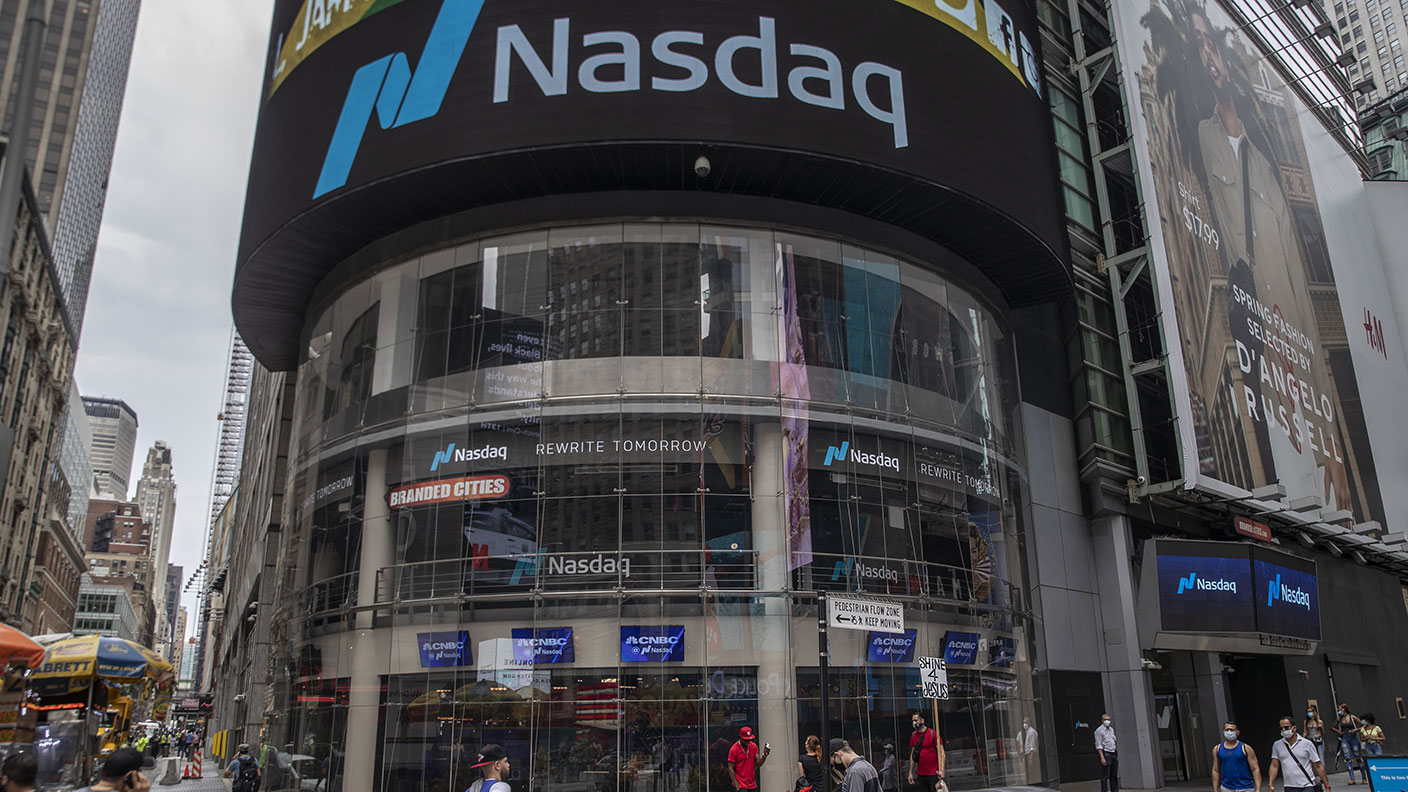Is the US tech bubble bursting, or is this just a blip?
America’s tech-heavy Nasdaq index slid by 5% yesterday – with Apple shares down by 8%. John Stepek asks if the bubble is finally bursting, and how it affects you and your portfolio.


US markets took a big knock yesterday. The technology index – the Nasdaq – fell by about 5%; Apple slid by 8%; Amazon, Microsoft and Google/Alphabet fell by more than 4%.
The S&P 500 was lower too – down 3.5%. And of course, with the US being the most important market in the world, our own rather less tech-heavy FTSE 100 fell too, though not by as much.
US tech stocks were already hugely overvalued. They still are. Is this it? Has the bubble been pricked or is it just a breather?
MoneyWeek
Subscribe to MoneyWeek today and get your first six magazine issues absolutely FREE

Sign up to Money Morning
Don't miss the latest investment and personal finances news, market analysis, plus money-saving tips with our free twice-daily newsletter
Don't miss the latest investment and personal finances news, market analysis, plus money-saving tips with our free twice-daily newsletter
Is this the big one?
When you’re looking at a “crash”, it’s always worth reminding yourself of the run up.
Here are a few statistics. Last month was the best August for the S&P 500 in nearly 40 years. Tesla's share price climbed by 74% in the last month alone. Investors appeared to be buying Tesla and Apple simply because they had conducted share splits.
To be clear, believing that a share split makes a company more valuable is like believing that cutting a cake into more pieces makes the cake bigger. It may be the case that there are suddenly lots of toddlers day-trading – I mean, they can use touch screens before they can read these days – but it rather smacks of exuberance.
My point is not to dismiss yesterday’s slide as inconsequential (though it may be). It’s just to remind you that for every “market bloodbath” headline, there’s a “market mania” headline that never got written, because we accept rising markets as the natural order of things.
You get the point. The market was ripe – overdue – for some sort of correction.
Of course, every big crash begins with “some sort of correction”. The question is: is this “the big one”?
The short answer is: I don’t know, and neither do you. The most obvious trigger - beyond general exuberance – was the US dollar. As we’ve discussed before, a weak dollar is generally good for markets.
The dollar is the most important currency in the world. Everyone needs it. When it’s cheap (ie, weak), there’s more money around. When it’s expensive (ie, strong), there’s less. More money = higher asset prices, all else being equal.
Recently, the dollar index – which looks at the dollar versus the currencies of its main trading partners – has been falling. In turn, that’s mostly because the dollar has been getting weaker against the euro.
Why? Well, the euro had a bit of a turnaround earlier this year when the heads of European states managed to reach a deal on a joint coronavirus relief package.
The deal may or may not progress the EU further down the road to integration. However, it did remove any concerns that another existential crisis might be looming. As a result, the euro started to strengthen.
The tricky thing is, everyone wants a weak currency right now. They won’t really admit it openly because that’s not really the done thing. But it’s unquestionably a source of concern for central bankers and politicians.
And it seems that the euro had finally reached a point where Europe’s policymakers got jittery. Earlier in the week, as the euro rose above $1.20 for the first time in two years (from around $1.06 as recently as March), the European Central Bank’s chief economist, Philip Lane, gently hinted that it wasn’t entirely welcome. “The euro-dollar rate does matter”, he said.
That’s enough to get investors worried that Europe’s central bankers might decide to weaken their own currency via more money printing (for example). That stopped the dollar slide in its tracks. And so you also get a good reason for a bit of a sell-off in markets.
My suggestion, as always, is to stick to your plan
Anyway, none of that matters.
This sort of thing only matters if you’re a trader. I don’t recommend short-term trading – it’s time-consuming, distracting and stressful, and most people who try it give up after losing a lot of money.
More to the point, if you are a trader, you should already have a plan in place for how to deal with this scenario. That’s what technical analysis is for, after all. (See my colleague Dominic’s piece from earlier this week for more on the trend line to watch out for in the Nasdaq).
So let’s park that. For longer-term investors, the main reason to understand what’s going on, is so that you can keep your head and not do anything stupid.
We’ve been saying for a long time that US tech stocks are overvalued. We’ve also acknowledged that it might go on for some time, which is one reason why the Scottish Mortgage Trust is a prominent holding in our model investment trust portfolio.
Situations like this are the reason that your portfolio is diversified. If your financial future hinges on the Nasdaq (or stocks more widely) going up non-stop for the next five years, then your asset allocation is inappropriate.
Increasingly, my view is that you should be looking at corrections and bear markets as opportunities to buy assets that you like, at a cheaper price. To be very clear, for me, that doesn’t currently include the Nasdaq.
But if other, more attractive assets get caught up in a sell-off as a result of a wider panic, you want to make sure that you are in a position to invest.
So as I’ve said before – if this little slip in the Nasdaq is making you sweat, then you need to take a look at your asset allocation, as it’s either unsuitable, or you don’t know enough about what’s in your portfolio.
And if I had to guess what’s next? I suspect this is a blip. And if it’s not, then the Federal Reserve – America’s central bank – will be making its presence felt later this month (the next meeting is in mid-September).
The Fed might tolerate a bit of froth being blown off the Nasdaq. But if it looks as though the already-frayed structure of the market might be put at risk by a sharp fall in asset prices, the Fed has pretty much already indicated that it won’t let it happen – not without a fight.
For more on valuations and where to find appealing opportunities right now, pick up the latest edition of MoneyWeek magazine. If you’re not already a subscriber, you can get your first six issues free here.
Get the latest financial news, insights and expert analysis from our award-winning MoneyWeek team, to help you understand what really matters when it comes to your finances.
John Stepek is a senior reporter at Bloomberg News and a former editor of MoneyWeek magazine. He graduated from Strathclyde University with a degree in psychology in 1996 and has always been fascinated by the gap between the way the market works in theory and the way it works in practice, and by how our deep-rooted instincts work against our best interests as investors.
He started out in journalism by writing articles about the specific business challenges facing family firms. In 2003, he took a job on the finance desk of Teletext, where he spent two years covering the markets and breaking financial news.
His work has been published in Families in Business, Shares magazine, Spear's Magazine, The Sunday Times, and The Spectator among others. He has also appeared as an expert commentator on BBC Radio 4's Today programme, BBC Radio Scotland, Newsnight, Daily Politics and Bloomberg. His first book, on contrarian investing, The Sceptical Investor, was released in March 2019. You can follow John on Twitter at @john_stepek.
-
 London claims victory in the Brexit wars
London claims victory in the Brexit warsOpinion JPMorgan Chase's decision to build a new headquarters in London is a huge vote of confidence and a sign that the City will remain Europe's key financial hub
-
 Rachel Reeves's Autumn Budget: What it means for the UK
Rachel Reeves's Autumn Budget: What it means for the UKOpinion A directionless and floundering government has ducked the hard choices at the Autumn Budget, says Simon Wilson
-
 What's behind the big shift in Japanese government bonds?
What's behind the big shift in Japanese government bonds?Rising long-term Japanese government bond yields point to growing nervousness about the future – and not just inflation
-
 Halifax: House price slump continues as prices slide for the sixth consecutive month
Halifax: House price slump continues as prices slide for the sixth consecutive monthUK house prices fell again in September as buyers returned, but the slowdown was not as fast as anticipated, latest Halifax data shows. Where are house prices falling the most?
-
 Rents hit a record high - but is the opportunity for buy-to-let investors still strong?
Rents hit a record high - but is the opportunity for buy-to-let investors still strong?UK rent prices have hit a record high with the average hitting over £1,200 a month says Rightmove. Are there still opportunities in buy-to-let?
-
 Pension savers turn to gold investments
Pension savers turn to gold investmentsInvestors are racing to buy gold to protect their pensions from a stock market correction and high inflation, experts say
-
 Where to find the best returns from student accommodation
Where to find the best returns from student accommodationStudent accommodation can be a lucrative investment if you know where to look.
-
 The world’s best bargain stocks
The world’s best bargain stocksSearching for bargain stocks with Alec Cutler of the Orbis Global Balanced Fund, who tells Andrew Van Sickle which sectors are being overlooked.
-
 Revealed: the cheapest cities to own a home in Britain
Revealed: the cheapest cities to own a home in BritainNew research reveals the cheapest cities to own a home, taking account of mortgage payments, utility bills and council tax
-
 UK recession: How to protect your portfolio
UK recession: How to protect your portfolioAs the UK recession is confirmed, we look at ways to protect your wealth.
